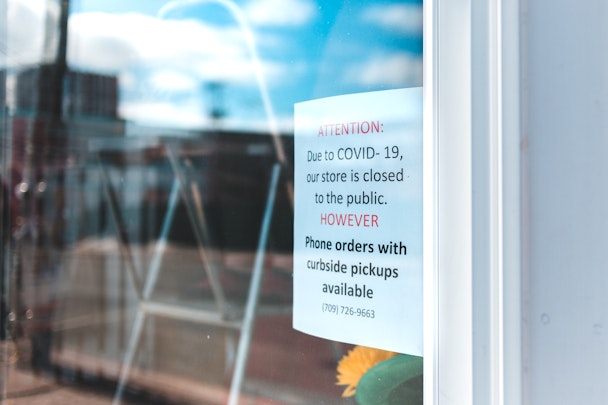The cost of living crisis is driving a return to pandemic-style shopping behaviors
In the face of inflation, some consumers have reverted back to a scarcity mindset, as Alex Van Gestel of EPAM Continuum finds.

Consumer behavior mimicks how it was during the pandemic – should brands take note? / Erik Mclean via Unsplash
At EPAM Continuum, we launched our Consumers Unmasked study to map the changing attitudes and behaviors of consumers during the pandemic, across four stages. Yet, as our study suggests (and the International Monetary Fund agrees), consumers will return to their well-trodden pandemic behaviors, as a third of the global economy will be in recession in 2023.
In stage four of the study, we explore trends that receded have and then returned to prominence. We ask industry experts how retailers should respond, and consider how the past has left it better able to respond to rapidly changing consumer needs.
Once again, value is all about price
Price was always one of the most important factors in how consumers calculate value, yet it was far from the only factor. At times during our study (most notably in the early days of lockdown uncertainty) consumers perceived value as a combination of price, quality, availability and choice.
Now, unsurprisingly, price has become the trigger. Consumers said they were willing to walk away from products – particularly lower-value items – if they felt confident in their ability to find cheaper elsewhere. Barbara Castiglia, executive editor for Modern Restaurant Management, looked at how food retailers should respond to this:
“Promoting the value message provides retailers with a key opportunity to retain consumers and gain new ones. Get creative – maybe partner with a local hospital or nutritionist for in-store demonstrations for nutritionally sound campaigns or videos on social media. Use store space to offer pairing suggestions, so they are easily accessible”.
Advertisement
Discounts and deals determine loyalty
During the pandemic, lockdowns left many shoppers with extra free time to search for deals. As life returned to normal, consumers had less time to search for discounts. Now, deals and discounts matter more, for obvious reasons. Brands that consistently offer low prices and great discounts will win consumer loyalty.
Michelle Grant, director of strategy and insights for retail and consumer goods at Salesforce, explains the challenge:
“Money talks and nothing says value more than rewarding loyal consumers with deals and discounts that aren’t available to anyone else. What retailers need to do is figure out which deals/discounts are most meaningful to which consumers, so they can provide personalized offers that maximize ROI at a customer level. A robust customer data platform coupled with savvy use of advanced analytics can enable this”.
Advertisement
Sustainability vs affordability
Sustainable and responsible shopping has never been far from consumers’ minds, yet, throughout our study, there has been constant tension between wanting to do good and actually doing it.
In this final stage of the study, most consumers said they wished to do good by buying sustainable products in a simple manner. They want quick, accessible information and straightforward buying processes from brands they trust. However, price remains the key driver for most shoppers. An unsustainable product that matches a buyer’s style, quality and (especially) price requirements will win out over a sustainable product that doesn’t. More than at any point in our study, shoppers are keen to buy sustainably but simply may not be able to afford it.
“Sustainable options aren’t always more expensive”, says my colleague Dan Smythe, vice president, retail and hospitality consulting at EPAM Continuum. “For example, consumers are often willing to select longer shipping times on online orders to support sustainable practices, even if they aren’t willing or able to pay more. The key for retailers is to couple sustainable practices with cost efficiency where possible and offer consumers choices and transparency so they can make trade-offs that work best for them”.
Grant identifies the opportunities for retailers: “Retailers need to lean into marketing the benefits of shopping sustainably, leaning into the innovation behind the product materials, highlighting the durability of these products and rewarding consumers for recycling the products. Another opportunity is to produce private-label products in a sustainable manner, sacrificing margin to keep pricing relatively stable to differentiate the private label against non-sustainable brands”.
Suggested newsletters for you
Ready for anything
Perhaps the only thing more impressive than the accelerated pace of changing consumer attitudes has been retail’s capacity to keep up with them. But the increase in hybrid, personalization, curbside and click-and-collect capability has, in some ways, made brands the victims of their own successes.
The success of UberEats, eBay and Etsy during the pandemic has led consumers to expect stores of all sizes and sectors to have online capability. However, consumers love blended experiences where they can test, try, smell, and feel products in stores, but also have the option to purchase online. Shopping is all about convenience for consumers, as demonstrated by continued demand for curbside pickup and click-and-collect services. It’s important that retailers continue understanding and adapting to consumer needs. Right now, that is predominantly price.
Consumers Unmasked succeeded in charting a longitudinal journey for today’s consumers. But we couldn’t have predicted the unexpected twists this trip would take. Nor could we have envisioned just how well and how fast the industry would be able to adapt and evolve. This is perhaps the true legacy of Consumers Unmasked: it’s a snapshot of a time when consumer needs changed faster than ever before; a quickly developed image of how the retail industry rose to meet that challenge.
You can download the full report here.
Content by The Drum Network member:

EPAM Continuum
Our diverse, integrated consulting teams apply a Systems Thinking mindset to get to the heart of our clients’ increasingly complex business challenges.
Our...

